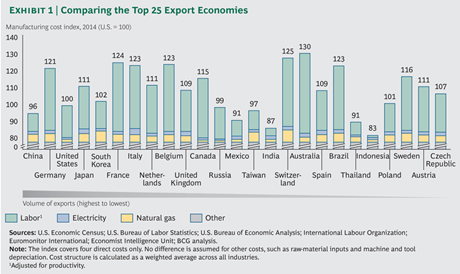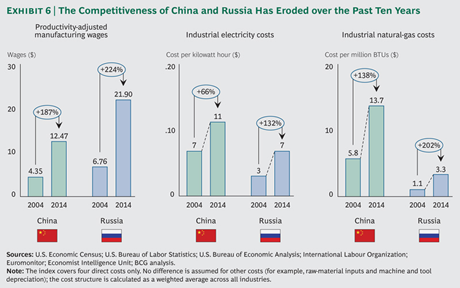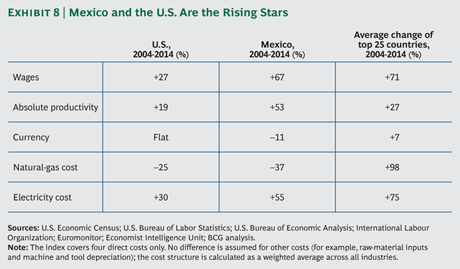Paving the Way through Energy Security & Clean Energy
These days a lot of people talk about how we live in challenging times. They’re not kidding, especially when by “challenging” they mean a freeze in international credit markets and a synchronized world economic slowdown. It’s no secret, we are in the middle of a global financial crisis, and when it comes to helping get the world economy back on track, Canada is all aboard.
Like the United States, Canada has already taken a number of actions to protect its own economy, which the International Monetary Fund predicted will continue to lead the G7 in financial growth in 2009. Canada is also committed to help stabilize global financial markets, restore credit flow and renew economic prosperity around the world. It will address these challenges by continuing to work closely with its G7, G8 and G20 partners, especially its neighbor, ally and number one trading partner the United States.
As part of this economic recovery strategy, Canada has made energy security and climate change top priorities. Prime Minister Stephen Harper and President Barack Obama recently discussed these key issues and vowed to tackle them together during their meeting in Ottawa on February 19, 2009.
President Obama and Prime Minister Harper Establish Clean Energy Dialogue
Noting the long and productive history of bilateral cooperation on continental environmental protection and energy trade and technology, the President and the Prime Minister agreed that environmental protection and the development of clean energy are inextricably linked and announced plans to work together to build a new energy economy as a key element of broader economic recovery and reinvestment efforts.
The two leaders also discussed ways Canada and the United States could encourage the development of clean energy technologies to reduce greenhouse gases and combat climate change. These talks resulted in the establishment of a senior-level Canada-U.S. Clean Energy Dialogue that will cooperate on several critical energy science and technology issues. Priority initiatives identified include: expand clean energy research and development; develop and deploy clean energy technology; and build a more efficient electricity grid based on clean and renewable generation. In the weeks following the meeting, Canadian and U.S. officials will meet and officially launch this new Canada-U.S. initiative. (See “Canada-U.S. Initiative for Tackling Climate Change & Energy Security” for more details).
Canada - Number One Supplier of Energy to the United States
For a deeper understanding of how Canada fits into the energy and environment equation for North America, it’s important to know the role that Canada plays today. First, Canada is the largest energy supplier to the United States including oil, natural gas, uranium and electricity. In fact, the United States imports more oil from Canada than it does from Saudi Arabia and Kuwait combined. And in 2007, Canada’s oil exports to the United States totaled more than $55 billion U.S., representing 2.4 million barrels per day.
Aside from its conventional oil and gas reserves, Canada’s oil sands in northern Alberta total an estimated 175 billion barrels of oil, which represents one of the largest sources of recoverable oil reserves in the world - second only to Saudi Arabia. Yet as technology and recovery techniques advance, the total oil reserves in Alberta’s oil sands are estimated to reach 1.7 trillion barrels, approximately four times the size of Saudi Arabia’s total reserves.
Roughly half of Canada’s crude oil exports to the United States are derived from Alberta’s oil sands, which provide a secure, dependable and long-term supply of oil for the North American market.
Canada’s Oil Sands and Sustainable Development Practices
Development of one of the world’s largest oil deposits brings both opportunities and issues. With such a huge energy resource come environmental challenges. To deal with these issues in a responsible and proactive manner, Canada is working with both provincial governments and the private sector to address how to secure the energy future in a way that is environmentally sound and sustainable. This involves balancing economic development with environmental and social responsibilities.
Production from Canadian oil sands is undertaken on a commercial basis in the context of transparent environmental regulatory and royalty regimes on greenhouse gas emissions, carbon dioxide capture and storage, water use and land reclamation, as well as water and natural gas use. U.S. companies are among the leading firms engaged in oil sands production, and project proposals to develop oil sands deposits are subject to extensive environmental and regulatory review. These permits are only granted once environmental issues and First Nations’ concerns have been addressed.
Canada’s Commitment to Environmental Stewardship
Canada understands that economic prosperity cannot be sustained without a healthy environment, just as environmental progress cannot be achieved without a healthy economy. It has committed to reducing Canada’s total greenhouse gas emissions by 20 percent by 2020 and by at least 50% by 2050. Meeting those goals will ensure that Canada’s ongoing actions remain comparable to those our partners in the United States, Europe and other industrialized countries undertake.
In support of this ambitious national goal, Canada will continue to provide support for biofuels, wind and other energy alternatives and will also bring in legislation to ban all bulk water transfers or exports from Canadian freshwater basins. Canada will work with all parties in Parliament to introduce sensible policies that can help consumers and improve our environmental well-being, such as increasing incentives for energy-saving home retrofits.
In addition, Canada will work with the provincial governments and our partners to develop and implement a North America-wide cap and trade system for greenhouse gases and an effective international protocol for the post-2012 period. Canada will set an objective that 90 percent of its electricity needs to be provided by non-emitting sources - such as hydro, nuclear, clean coal or wind power - by 2020.
In early 2009, Canada’s Minister of the Environment Jim Prentice gave an address to the Canadian Council of Chief Executives reaffirming Canada’s commitment to environmental stewardship. During the speech, Minister Prentice stated that the Government of Canada has resolved to make national environmental policies positive instruments of economic renewal and of national development during this period of economic uncertainty. He also said that Canada is committed to helping achieve an effective multilateral climate change agreement for the years ahead. Canada will also continue working with the United States to pursue coordinated approaches to energy and environmental challenges that both face, which was further discussed during Prime Minister Harper’s and President Obama’s meeting.
Achieving these objectives will not be easy. But progress is being made on three concurrent tracks, including the previously mentioned Climate Change Policy that Canada introduced in 2007. As stated, this strategy sets a target to reduce total greenhouse gas emissions in Canada in 2020 by 20 percent from a 2006 starting point, also known as the minus 20 by 2020 approach.
While ambitious, Canada believes these target reductions in greenhouse gases are achievable - a promise to the global community that we think Canada will be able to keep. It’s a commitment that requires a greater effort of Canadians than the one proposed by the E.U. 27.
Going forward, Canada is developing a regulatory regime with mandatory targets that will apply to major industrial emitters
President Barack Obama spoke with clarity and determination about his commitment to environmental issues. The United States is re-engaging on multilateral climate change negotiations, creating the opportunity for a North American regulatory regime and a level playing field.
The Canadian Government looks forward to working with the Obama administration on energy security and environmental sustainability.
We will seek to ensure our federal policies are coordinated. We want federal climate change regulation to work in tandem with tax, tariff and technology policies, as well as all other policies that promote timely domestic investment.
Canada is also working to coordinate and harmonize federal and provincial governments and policies.
Concurrent with such measured movement in Canada, we hope to make progress internationally. In 2009, we will work with other countries to negotiate an effective multilateral climate change accord for the years ahead. Key meetings will take place in Bonn in early April and June, as well as in Italy at the June G-8 meeting. Finally, all roads will lead to the Copenhagen Conference in December 2009.
It is Canada’s hope that future climate change agreements will be effective. Climate change is a global problem and requires a global solution, which means all major emitters, developed and developing nations, need to be part of any new accord
Industrialized nations, to be sure, must be prepared to lead the charge provided all major emitters agree to follow, because if industrialized countries exercise leadership without emerging economies countries coming on board, real progress will not be made.
Climate change is a global problem and requires a global solution, which means all major emitters, developed and developing nations, need to be part of any new accord.
Moving forward, we need to ensure comparable efforts from all industrialized nations. We also need to secure meaningful participation from all emerging economies led by the “Big Five” of China, India, Brazil, South Africa and our NAFTA partner Mexico. We need to focus as well on the development and deployment of transformative clean technology and a concerted effort to produce and transmit a greater percentage of cleaner base-load power.
These are principles that Canada believes could and should form the basis of one shared commitment between Canada and the United States similar to the collective commitment of the European Union. A bilateral agreement could have shared targets and shared timetables, a common carbon market and price standard, and mandates that are based on science and common sense. But we think that the two countries need to go further and talk in terms of concrete action plans. Actions that will reduce not just greenhouse gas emission levels but North America’s dependence on foreign oil, such as the soon-to-be-launched Clean Energy Dialogue, established by President Obama and Prime Minister Harper.
Forty years ago, imported oil accounted for about 10 percent of the American market with Americans producing approximately 90 percent of their own consumption. Today that 10/90 ratio has become 60/40. By 2020, it will likely be at 80/20, because at current rates of production and exponential increases in consumption—SUVs and plasma TVs for example—proven U.S. oil reserves, like those of Mexico, are on course to be depleted just one decade from now. This means that by 2020, the United States will be as dependent on imported oil as E.U. nations.
So while Canada already plays a major role in the North American energy equation, we have the capacity to play an even larger role in the North American energy solution. We believe that working together we can reconcile energy and the environment and still have a secure and environmentally sustainable energy future for both our nations.
It is increasingly important that Canada plays a larger role in the North American energy security solution, when one considers the implications of oil scarcity and the political situations in Russia, Venezuela or the troubled Middle East. Considering these factors, Canada’s status as the world’s most reliable supplier of energy becomes not just an economic opportunity but also an obligation to our international partners and perhaps the single best way that we can contribute much-needed stability in an uncertain world.
Opportunity and obligation are why Canada needs to work with the United States in developing cooperative bilateral action plans. These joint strategies could include bringing northern gas to southern customers; clean technology roadmaps that would optimize the considerable expertise of both countries in areas such as carbon capture and storage; plans to expand clean power generation and transmission capacity here in North America or to interconnect the eastern and western regional power grids in North America; and actions that will help North America and the world make the transition from a high carbon present to a low carbon future while avoiding a disruptive and dislocative period involving no carbon en route.
Finally, as Canada gains traction domestically on approaches to dealing with energy security and environmental stewardship, we are able to make a credible commitment to the international community that Canada will play a key role in the effort to stabilize greenhouse gas emissions. Canada will achieve this by also working with our neighbor and closest ally, the United States, in order to devise and execute a coordinated plan of action that will advance our environmental and our energy objectives and, at the same time, renew the North American economy.
Ambitious? Perhaps it is.
Achievable? We think so.
But of this I am certain: as North Americans, this is an agenda that is worth our very best efforts in the days ahead.
Dale Eisler (BA in Political Science at the University of Saskatchewan, Regina Campus; MA in Political Science at Vermont College, Union Institute & University).
Prior to joining the Canadian Federal Government, Mr. Eisler had an extensive career in journalism, including daily newspapers, weekly newsmagazines, syndicated opinion columns, radio and television. He was also a sessional lecturer in journalism at the University of Regina.
In addition, Mr. Eisler was involved, at an ownership level, in private business for 13 years.
In 1998, he was appointed Assistant Deputy Minister for Consultations and Communications with the Department of Finance in the Government of Canada. In 2004, he was appointed Assistant Secretary to Cabinet (Communications and Consultations) at the Privy Council Office, which was the most senior communications position in the Canadian Government.
In 2006, Mr. Eisler was the recipient of the Saskatchewan Commemorative Medal in recognition of his contributions to the province and society. He is the author of two books, most recently False Expectations: Politics and the Pursuit of the Saskatchewan Myth, published by the University of Regina in 2006. Recently, he was awarded the University of Regina’s distinguished alumni award for professional achievement.
Dale Eisler and his wife Louise took up residence in Denver in November 2007. They have one daughter and one granddaughter.











